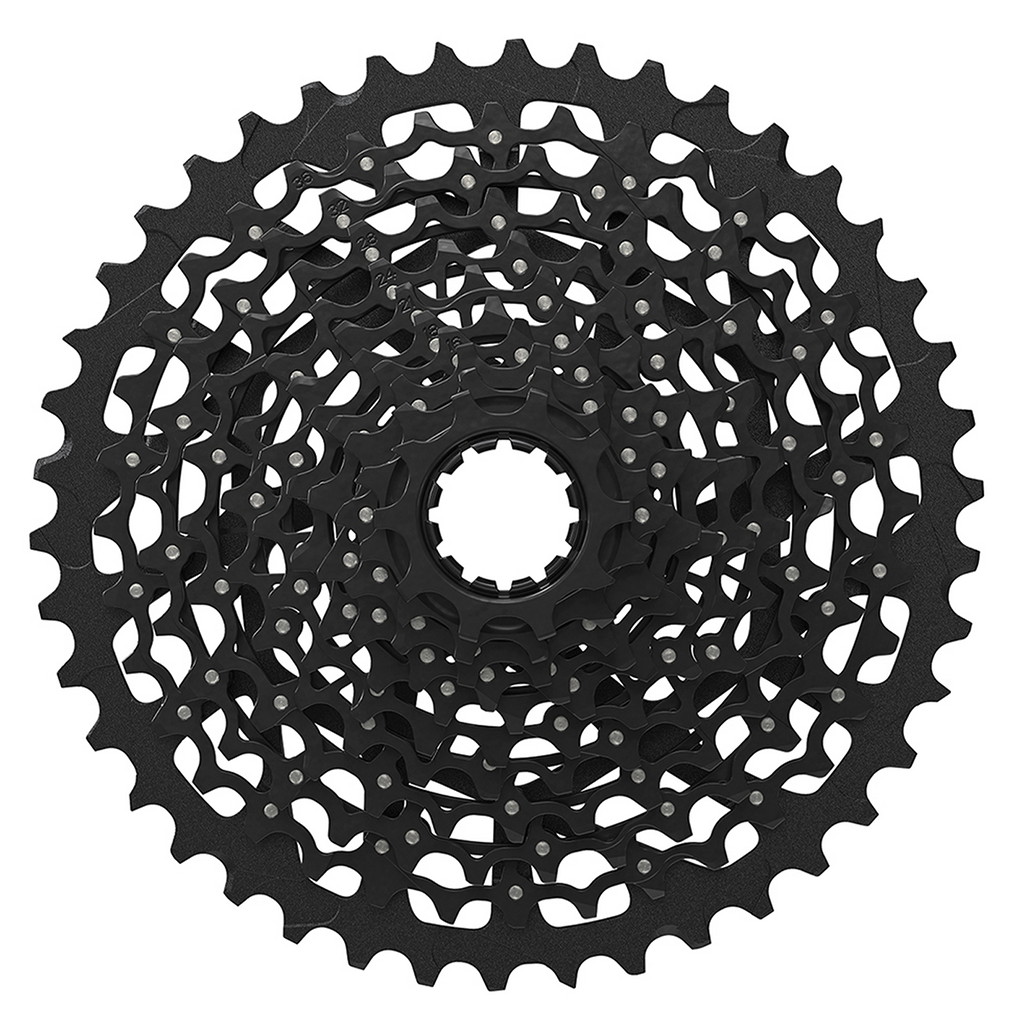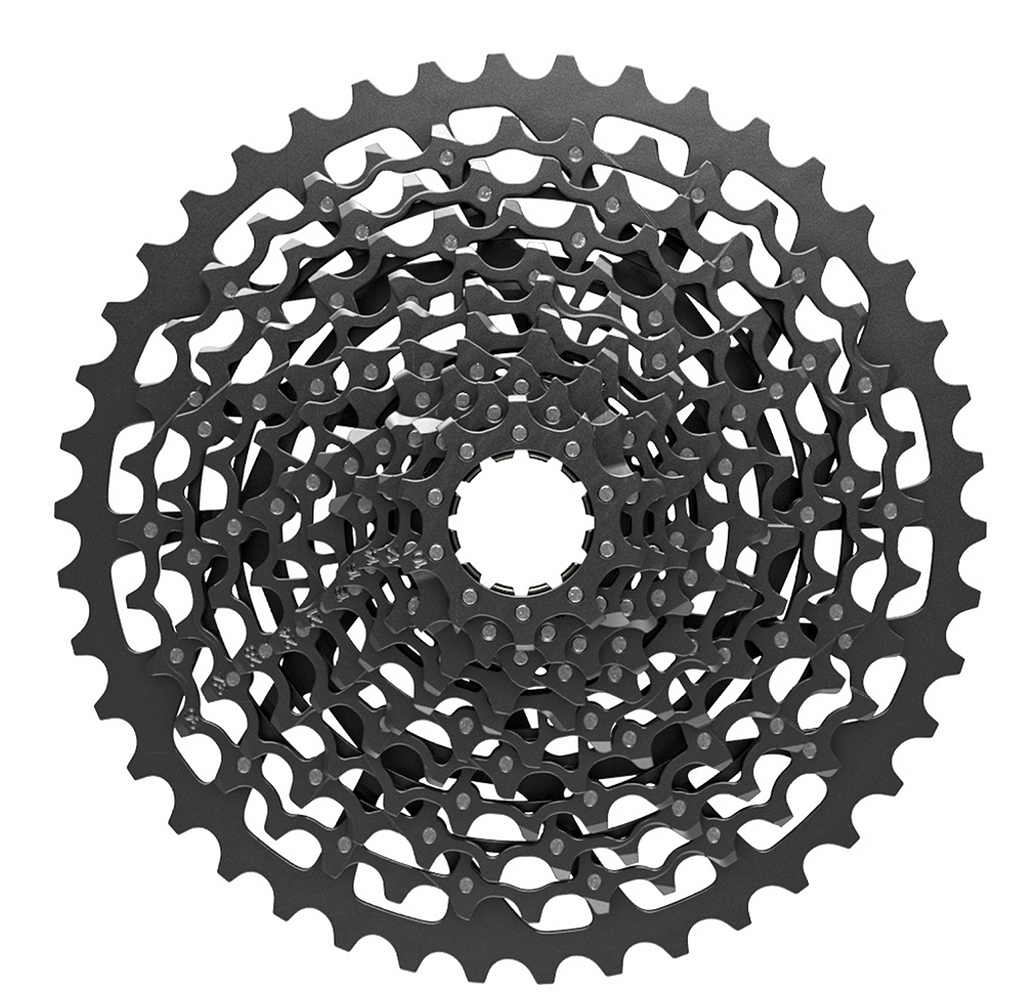Construction Differences Between GX and X1
SRAM made the GX kit cheaper in two primary ways:
(1) They changed the rear derailleur from forged aluminum to cast aluminum.
(2) They used a riveted cassette similar to X1, but unlike X1, the three smallest cogs are riveted together instead of machined from a single block. Both of these changes increase weight, but reduce cost.
Riveted cassette construction is fairly standard. It isn’t as light or cool as the one-piece construction that SRAM uses on their more expensive cassettes, but I’d be surprised if it presents any issues. Maybe it will collect more mud, but that has never been a significant problem for me on any number of riveted 9- or 10-speed cassettes I’ve run over the years.
Cast aluminum, however, is something I’m a bit leery of. Casting is a much less expensive technique than aluminum casting, so it likely helped SRAM hit their desired price point. But I worry that it might make the derailleur less durable and less precise.
(Aluminum forging molds aluminum pieces into a formed shape with heat and a great deal of pressure. This yields a very stiff and strong part. In aluminum casting, molten aluminum is poured into a mold, then allowed to cure. This is a great way to make a part with little material waste. However, air bubbles or other defects can occur with this technique, and the strength of the resulting part often isn’t particularly high, relative to forging.)
The Ride
Getting the GX drivetrain dialed in took a little while, longer than I’m used to with Shimano or SRAM systems. I suspect that this is at the root of the tuning challenge. It could also be the result of imprecision in the shifter, but the shifter seems to be much more similar to the X1 version than the derailleur.
Once I got out on the trail, my first impression was how positive the shifting was. It has a strong “clunk” when shifting both up and down. It is much more distinct than X1, and more positive than Shimano 10-speed options.

Coming off a Shimano 1×10 setup most recently, I quickly remembered that I really like the SRAM shifter ergonomics, and prefer pushing the shift release lever upward instead of forward or back. I think it is easier to stab at the SRAM levers blindly and get the necessary result (when compared to the Shimano levers that are closer together).
I did, however, miss the double downshifts that Shimano’s XT and XTR allow. I find a double shift to be perfect for undulating terrain. This isn’t at all critical, but it is worth noting.
The GX shifting is quick, but not quite as quick as on the more expensive SRAM lines or Shimano XT or XTR.
As I mention above, tuning is a bit harder / more particular than on the more expensive options, and as such, it is hard to get quite the same performance out of GX that one might get out of X1.
So one of my biggest, initial questions has been answered: GX isn’t bad, but it does represent the first real step down in shifting performance in the SRAM 11 speed lineup.
I’ll say it again: GX isn’t bad, it just doesn’t follow SRAM’s remarkable run of getting almost exactly the same shifting performance out of less expensive components.
The bottom bracket and cranks have both been great. The GX 1400 cranks are identical to the X1 1400 cranks as far as I can tell. Both are hollow, forged aluminum.
SRAM identifies the X1 1400 crank as being made of 6000 series aluminum, while they describe the GX 1400 crank as being Open Core Technology (OCT™) Aluminum. I’m guessing they are two names for the same material. The cranks are stiff, smooth looking and offer a direct mount chainring option.
The bottom bracket has held up so far, but I would have been very disappointed if it hadn’t. It has seen a bit of mud and a lot of dust, but not enough miles to start creaking. I’ll keep riding it and update if and when anything changes.
The GX chain is the same as the X1, and has held up fine. But I’ll need to check back in once it has more miles on it to report on durability.
The steel cogs on the cassette don’t yet show any signs of wear, and there are only very small wear marks on the 42t aluminum cog.

The cassette has worked beautifully so far for me. It could be that it is holding back shifting performance relative to a more expensive cassette, but I don’t believe so, as the shift ramps appear to be identical to the X1 cassette. See the images below. These show the X1 cassette and the less expensive 1150 cassette. Ignoring the 42t cog on the 1150 cassette since the 1175 cassette has a ramped, aluminum 42t cog, you’ll note that all the other cogs have very similar if not identical shift ramps to the X1 cassette.


NEXT: Comparisons, Bottom Line

Awesome review! I’m still on a 3×9 =( this may finally be cheap enough for me to switch. (On a serious note should probably save for a new bike now)
Thanks Yuhao! It is always a tough call when to upgrade and when to move on to a new bike. I wish you the best of luck with the decision!
The rear derailleur is still $110. Considering I go through around 2-3 rear derailleurs per season, the $35 Deore M615 derailleur is fine by me. $330 vs $105 is a no-brainer.
Manual 2×10 with a 30/36 chainrings and 11-40 OneUp seems to be working just fine for me – even when hitting the double-blacks at the bike park (no chain guide needed yet).
Lindahl,
It is great to hear of unique setups. I went through a long period where I tore apart rear derailleurs with some frequency. I also ran $35 Deore rear derailleurs during that time. They offer a great value for the price.
Hi Tom,
Thank you for the first proper review of the GX drive train.
It was sad to read that it’s the first 11 group that trickled down performance from the Sram lineup since I had big hopes for it to make me change my 2×10 setup.
Therefore I can’t wait no longer so I want to make the jump for 1x system so what do you think, if I’m gonna take all the package from Gx except the rear derailleur (I would get the X1) will it perform mostly like the upper in Sram’s lineup with no flaws?
By the way, have anyone noticed if you flip ” X9″ 180 degrees you get a GX? It could make sense in some ways.
Hi Bogdan,
I’d still take GX over any 2×10 setup and I’m still happily using the setup I reviewed. I do think that upgrading to an X1 rear derailleur will likely improve performance and it will definitely improve durability. It should perform mostly like the upper SRAM lineup and will definitely be a step up from 2×10. Make sure that you get an XD hub driver too.
Interesting observation. I hadn’t noticed that.
-Tom
I’m interested in this system. Right now I’m running SRAM X9 on the rear drivetrain. How does GX compare to that?
I haven’t run X9 since 2012, but I do feel strongly that 1×11 is superior to 2×10 and GX is better than X9 from 2012.
-Tom
Hi tom. Excellent review. Thank you!
I’m currently running XT 2×10. Drive train is shot so time to replace/upgrade.
I’m very interested in the GX. How would you say it compares to shimanos new 1×11 xt?
Mike,
It comes down to ergonomics for me. You will likely either prefer the dual-direction, dual downshift Shimano levers or the SRAM levers.
The XT system also might be more durable, but the difference isn’t significant.
I prefer the GX system, but I’m sure many people prefer the XT system.
hi Tom,
how do you compare the 11speed GX and XT M8000 shifter and derailleur. which is which in terms of performance?
Tomas,
Take a look at my Shimano review http://blistergearreview.com/gear-reviews/shimano-xt-11-speed-drivetrain
I cover that question there.
Hi Tom!!
That’s one of the best 1×11 drivetrain reviews I’ve read!
Recently bought a Sram Gx 1×11 system with an XX1 crankset.Firtsly everything was smooth and quite but after a short period,shifting performance yield fell and chain start bouncing a lot but hopefully dont get of the chainring.
I will sent it back for inspection and propably I will buy a new X1 or X01 fore better performance.Maybe I’ll change and the shifter too if bad shifting continuous.My previous 1×10 x9 with 42 cassette cog set up was perfect.
Hi Nick,
Thanks for the kind words. Your problem sounds like it was probably caused by of one of the following: bent component, worn cassette/chainring, or misadjustment. Recognize I’m just hearing your problem from the other side of the internet so there are almost certainly details I’m missing. I hope the inspection solves your problems.